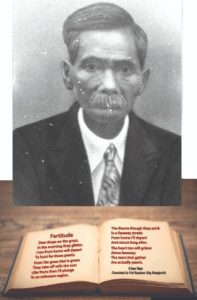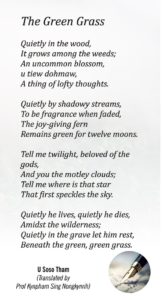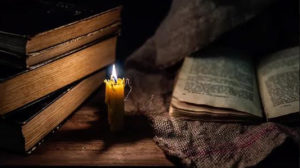By Ratan Bhattacharjee
 He was the son of the soil, the Cherrapunji poet of rains and rainbow, and the poet of the limbo-land.
He was the son of the soil, the Cherrapunji poet of rains and rainbow, and the poet of the limbo-land.
Born to Hag Tongper and Lyngkien Tham in 1873, he struggled hard to study, become a high school teacher and leave behind a rich legacy of Khasi literature, placing Cherrapunji on the cultural map of Meghalaya and the country beyond.
In December 2021, the statue of the national bard of Khasi literature was unveiled in Sohra to commemorate his 81st death anniversary. The Khasi Department of NEHU has an extensive library containing a large number of books on Soso Tham. Kynpham Sing Nongkynrih wrote ‘Hiraeth and the Poetry of Soso Tham’, a wonderful book on the bard. This book published by Ri Khasi Books and North Eastern India for Indigenous Studies, Shillong, mentioned Soso Tham  as the ‘Khasi National Bard’.
as the ‘Khasi National Bard’.
Professors Antoinette Kharmalki, Bandarlin Bairo and Marbhador M. Khymdeit of NEHU’s Khasi Department made tremendous efforts to develop and enrich the Khasi language and literature over two decades. Professor Badaplin War provided some facts on Tham and referred to Nongkynrih’s book on the great poet.
Nongkynrih’s translations retain the flavour of Tham’s poetry. In ‘The Green Grass’, Tham regards u tiew dohmaw, a wild flower as a symbol of great wisdom: “Quietly in the wood/ It grows among the weeds./An uncommon blossom, u tiew dohmaw/ A thing of lofty thoughts”. In ‘The Days that are Gone’ he refers to his own birthplace: “I will go to Sohra to be among the hills,/ The land of u tiew sohkhah and u tiew pawing lum/ The land of ka sim pieng, the land of u kaitor/The land of valour, the land of  culture.”
culture.”
Thus, Tham can be also called a poet of flowers and songbirds. Like Keats, Tham names flowers, waterfalls and rivers not only because he delights in them or because of the stories they tell, but also to the question: “Where do we come from?” It is a question of identity not merely for the Khasi but for many others living in the North-East.
It was in 1935 that the cultural map was poetically drawn for the Khasis when Tham, known as the Father of Khasi poetry, had completed a classic in Khasi literature and the Shillong  Printing Works published ‘The Old Days of the Khasis (Ki Sngi Barim U Hyniewtrep) in which his voice cradled the vast soul of his people. Tham seemed to have come from the wilderness to carve in wood the identity of his people. Thomas Jones came to Khasi Hills in 1841 to adamantly focus on the need to teach the Khasis to read and write their own language before they read in English. Tham tried to fill the void by writing in Khasi his poems. Still, the translation of Tham’s Khasi poetry got a global reception and credit goes to the Shillong-born Janet Hujon, a Masters from NEHU and a PhD scholar from Cambridge. She did justice to Tham and the translation maintained the
Printing Works published ‘The Old Days of the Khasis (Ki Sngi Barim U Hyniewtrep) in which his voice cradled the vast soul of his people. Tham seemed to have come from the wilderness to carve in wood the identity of his people. Thomas Jones came to Khasi Hills in 1841 to adamantly focus on the need to teach the Khasis to read and write their own language before they read in English. Tham tried to fill the void by writing in Khasi his poems. Still, the translation of Tham’s Khasi poetry got a global reception and credit goes to the Shillong-born Janet Hujon, a Masters from NEHU and a PhD scholar from Cambridge. She did justice to Tham and the translation maintained the  right tempo of creativity.
right tempo of creativity.
Literary history is not just the immediate past but the distant past and not just the literature of his or her own country but the whole ‘mind of a nation or a continent’. Sensibility for a poet like Tham is always terrific responsiveness to feeling, emotion and thought of the land where he lives and it got a crystal clear projection in his creative wonders from ‘The Khasi Folktales’, ‘About Darkness and Light’, ‘Grains of Gold’ (Ki Symboh Ksiar), ‘The Flower Garden’ (Ka Persyntiew), ‘The Natural World’ (Pyrthei Mariang), ‘The Cloud’ (U Lyoh), ‘The Dark One’ (U Rngiew), ‘The Rainbow’ (U Simpyllieng), ‘Home’ (Ka Ling I Mei), ‘Gentle Motherland’ (Ka Merilung), ‘Lamare Peak’ (Lum Lamare) to the ‘Season of Gold’ (Ka Aiom Ksiar).
As the poet of the landscape, myth and memory, he made his creative works a cultural signpost for the Khasis. Even as a translator, he left behind ‘Ka Duitara Ksiar” (The Golden Harp) comprising 46 short poems, lyrics, ballads and nursery rhymes, and 14 translations of various English poets. His other creation, ‘Ki Sngi Ba Rim U Hynniewtrep’ (The Olden Days of  U Hynniewtrep) is considered a masterpiece of Indian literature, a single long poem having 181 stanzas of six lines divided into 10 sections. His translation of Aesop’s Fables into the Khasi language or Charles Dickens’ ‘The Life of Our Lord’ and the Shakespearean comedy ‘The Tempest’ (U Kyllang) were more a trans-creation. He was the first person to make use of Khasi idioms in a form taken mainly from English poetry.
U Hynniewtrep) is considered a masterpiece of Indian literature, a single long poem having 181 stanzas of six lines divided into 10 sections. His translation of Aesop’s Fables into the Khasi language or Charles Dickens’ ‘The Life of Our Lord’ and the Shakespearean comedy ‘The Tempest’ (U Kyllang) were more a trans-creation. He was the first person to make use of Khasi idioms in a form taken mainly from English poetry.
Like all Khasi people, Soso Tham lived in a limbo which he poeticises and had terrible nights of darkness but with the dawn of hope and light, he went back in his poems to his childhood and to the daily rituals where the sacred codes of life were affirmed. People with no evidence of written history were without foundation or worth. “Which gods have made your slopes their home?” asked Tham in ‘Lum Lamar’ (Lamare Peak) which is a dreamlike meandering  through memory, myth, reflection and the immediacy of experience found in the simple pleasures of daily life. This going to the roots is emphasised also by renowned Khasi poet Daiarisa Rumnong, a professor of English at St Mary’s College who said in “Speak Your Roots’ that the renaissance of Khasi literature tapered after beginning by the 2000s. Many novels and folklore compilations are out of print and scholarly manuscripts are not open to the people in digital versions, not even in NEHU. We should leave language puritanism when a poet like Soso Tham is reaching out to the global reception.
through memory, myth, reflection and the immediacy of experience found in the simple pleasures of daily life. This going to the roots is emphasised also by renowned Khasi poet Daiarisa Rumnong, a professor of English at St Mary’s College who said in “Speak Your Roots’ that the renaissance of Khasi literature tapered after beginning by the 2000s. Many novels and folklore compilations are out of print and scholarly manuscripts are not open to the people in digital versions, not even in NEHU. We should leave language puritanism when a poet like Soso Tham is reaching out to the global reception.
 Tham searched the past not as a dark place but as a source of light, of enlightenment. It may lie buried but it is not dead. His heart bled when he saw the Khasi and Jaiñtia Hills plundered. Tham composed his masterpiece ‘The Flower Garden’ (Ka Persyntiew) ‘On bracing hillcrests, shielded lee/Refreshed I walk, alone reflect/Upon my homeland’s darkened heart,/Then under every thatch I find/Scattered grains of thought profound/Alive in pools of haunting tears’.
Tham searched the past not as a dark place but as a source of light, of enlightenment. It may lie buried but it is not dead. His heart bled when he saw the Khasi and Jaiñtia Hills plundered. Tham composed his masterpiece ‘The Flower Garden’ (Ka Persyntiew) ‘On bracing hillcrests, shielded lee/Refreshed I walk, alone reflect/Upon my homeland’s darkened heart,/Then under every thatch I find/Scattered grains of thought profound/Alive in pools of haunting tears’.
As in the mystic poetry of G.M. Hopkins or Wordsworth, Tham found beauty in the natural descriptions, even in pantheism.



